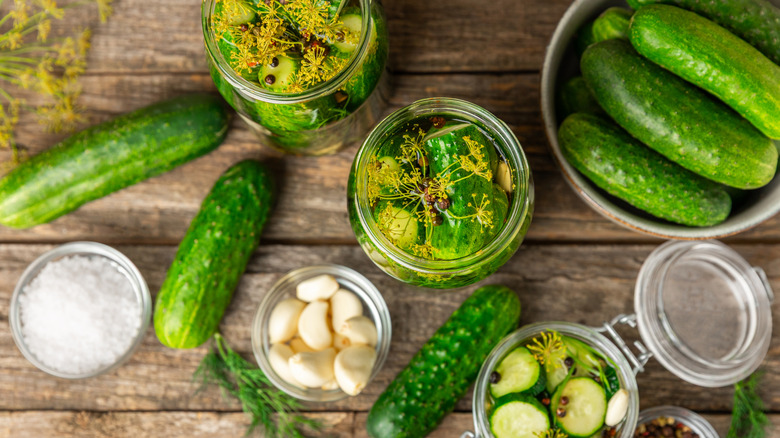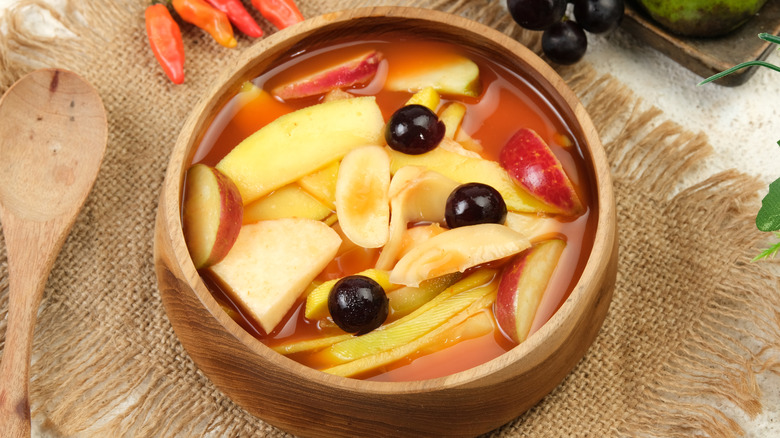Refrigerator Pickles Are The Tasty Snack Anyone Can Make. Here's How It Works
Pickles might not be everyone's favorite pick, but they're the go-to for many who feel these ancient preparations help pickle their life (couldn't resist the pun). Pickling has been around for thousands of years — since 2400 B.C., to be precise, and was primarily used for preserving food. Preparing these zingy little guys doesn't have to be elaborate. While fermented pickles — which develop acidity naturally through bacterial action — can take weeks, even months, to be ready for consumption, some pickles can be ready to eat in as little as a day. These refrigerator pickles work a little differently and don't need too many ingredients. You'll just need to stir up a simple brine made with plenty of vinegar and, depending on what you're aiming for, a few spices to give them the taste and tang you're after.
Vinegar is the primary ingredient for quick pickles; it not only helps with preservation, but the acetic acid also inhibits spoilage-causing microorganisms. Refrigeration, on the other hand, slows down any remaining enzyme activity, helping the pickles stay crisp and preventing them from developing mold and yeast. If you're just diving into the world of pickles, you might want to check out our ultimate guide to pickles to familiarize yourself with this time-tested (and surprisingly scientific) technique.
It's best to start with cucumber if you're a beginner
In case you're wondering, the easiest place to start when trying your hand at refrigerator pickles is with cucumber pickles. All you need to do is add sugar and salt to a nonreactive container of water and bring it to a boil. Stir in an equal amount of vinegar, then let the mixture cool completely. Once chilled, drop sliced cucumbers into a jar and pour the brine over them. You can also sprinkle some MSG into your pickle brine to amp up the umami flavor. Toss in some mustard seeds, garlic, and dill, then refrigerate. They'll be ready to tuck into your sandwich or burger by the next day.
One thing you might want to keep in mind is to always use Kirby cucumbers. Their smaller size and firm texture help them stay crunchy, unlike regular slicing cucumbers, which tend to go soggy. You'll also need to make sure the jars and lids are sterilized before filling them up. This goes for any pickle to help prevent bacterial growth and spoilage.
Cucumber is a classic, but refrigerated pickles can go way beyond
While cucumber is a popular choice for pickled vegetables (and definitely more versatile, especially if you want to use pickles as toppings for your pizza or slip them between sandwiches), you can pickle just about any vegetable. Think of it like choosing pizza toppings, even the controversial ones (looking at you, pineapple). Speaking of which, pineapple actually makes a great candidate for refrigerator pickles, especially if you live somewhere warm. Popping a chilled pineapple pickle straight from the fridge into your mouth on a hot summer afternoon can feel sublime. If you're someone who enjoys a puckery punch of sharp tang and spice, try tossing in a few jalapeños, Tajin seasoning, or even some cilantro. The brine also doubles nicely as a zippy salad dressing if you're in the mood for a little kick.
Carrots and beets, or carrots and onions, also work well for quick pickles. Just a quick note on brine: While you can reuse the same batch to make more pickles, it's best to skip reusing the batch from onion pickles. You don't want that lingering smell to sneak into your other pickled veggies. You can refrigerate these pickles for up to a month, so there's no need to worry about them going bad if you're making a big batch.


